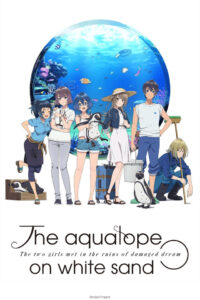 Welcome to our record-breaking 7th guest review in 2 months! This is made possible entirely through the support of our Okazu Patrons and the energy and talent of our guest reviewers! I’m absolutely delighted to bring you so many guest reviews and hope that, if you enjoy these, you’ll become an Ozazu Patron and help us continue to pay our writers industry standard rates for their efforts!
Welcome to our record-breaking 7th guest review in 2 months! This is made possible entirely through the support of our Okazu Patrons and the energy and talent of our guest reviewers! I’m absolutely delighted to bring you so many guest reviews and hope that, if you enjoy these, you’ll become an Ozazu Patron and help us continue to pay our writers industry standard rates for their efforts!
Today we’re bringing back Megan with a thoughtful and lovely look at one of this years prettiest anime, The Aquatope on White Sand, streaming now on Crunchyroll. (I asked to cover the second cour myself, so we’ll be back early next year season to talk about the rest of it. ^_^) In the mean time, please welcome Megan back! The mic is yours, Megan.
The Summer 2021 anime season saw the debut of not one, but two Yuri anime from fan favourite studios.
Season 2 of Dragon Maid drew most of the attention, but the original 2-cour series from PA Works studio,
The Aquatope on White Sand, also quickly drew a Yuri audience.
Aquatope begins with a young woman, Fuuka, leaving her idol job in Tokyo after she gave an opportunity up for another member of the group. Her dream is over, but on a whim she takes a flight to Okinawa where she meets Kukuru, the acting director of Gama Gama aquarium. With only weeks to go before the planned closure of the aquarium, Fuuka decides to support Kukuru with her dream of keeping Gama Gama open.
The entire cast is likeable, but the bulk of development goes to our leads, Fuuka and Kukuru. Fuuka is kind, almost to a fault; both with her idol and aquarium jobs, she prioritises others’ dreams above her own. Her arc sees her grow in confidence and learn to pursue her own dream again. Kukuru was the bigger surprise of the two leads. From the promo material and first episode I didn’t expect her to be quite as serious and focused on her work as the aquarium’s director as she turned out to be. The dynamic between the girls also works out differently than you might expect at first: in the early episodes Kukuru is the one giving emotional support to Fuuka as she faces up to her mother in episode 5, but in the second half of this first cour Fuuka emerges as the more mature of the pair.
While the show’s first half doesn’t definitively commit to a friendship or romance reading for Fuuka and Kukuru’s relationship (the show’s awkward attempt in episode 9 to advance a “big sister” interpretation for Fuuka is one of the writings’ rare missteps), either way there is a lot to offer here for Yuri viewers. Aquatope depicts the pair’s emotional intimacy beautifully, with both their emotional and physical closeness growing as they support each other with running the aquarium and overcoming their own issues. Wherever the second half of the show takes them, here’s hoping they have a future together.
The other main character of Aquatope could be said to be the aquarium itself. When the first episode aired and included a magical realist scene of Fuuka getting swept up in an underwater vision, I was sceptical since the show seemed otherwise well-grounded, but the magical element ended up working in the show’s favour. The pairing of an aquarium with these ineffable magical visions makes thematic sense; even now, so much of the sea is still a mystery to us. In several episodes we also meet characters who have visions at the aquarium that help them move on from turning points in their lives. Along with the stories of the supporting cast, this helps build a connection to Gama Gama as a place that feels worth saving.
The aquarium feels like a believable location thanks to the fantastic animation effort from PA Works. Where Aquatope might lack in impressive “sakuga” sequences, it makes up for with a consistent high quality both in the character and background art throughout these first 12 episodes. The fish are mostly rendered in CGI, but it looks acceptable, and closeups and the penguins are animated in 2D. Particular praise should be given to the background art team, Gama Gama and surroundings were so well-rendered they came off as real places.
Spoiler warning: Please skip past the section starred off below, if you prefer to remain spoiler-free.
***
***
***
***
For a “iyashikei” (healing) anime, Aquatope often struck a serious, even melancholic note from the early episodes. The closing episodes of this first cour paid off these hints, and secured my recommendation of the show for mature anime viewers who find it increasingly hard to relate to the teen-centered themes of most anime. The first cour of Aquatope is about the experience that, perhaps as much as any other, defines becoming an adult: giving up your dream.
It testifies to the show’s strong writing, no matter how much we as the viewer might wish for a different outcome, the closure of Gama Gama feels like a logical conclusion to everything that came before. We’d seen how unsuccessful Kukuru’s initiatives to draw visitors to the aquarium had been, and episode 10 introduces a new, much larger and more centrally located aquarium opening up that renders Gama Gama aquarium irrelevant. In truth, the writing had been on the wall since the start, and Kukuru locking herself up in the aquarium as a typhoon beats down her attempts to fortify the building is an effective visual for both Kukuru and perhaps the viewer’s denial of the reality of the imminent closure.
The finality of episode 12 is surprising for a two-cour show. Many people I know watching week-by-week thought it actually was the final episode and were surprised to find out it was only the halfway point. For viewers who usually like their anime on the shorter side, the first cour presents a satisfying and complete story on its own, without the meandering some other two-cour anime can fall prey to, with almost every episode developing the leads and their relationship, or the aquarium setting itself in important ways. This pacing helps Aquatope to feel, in my experience, more consistently engaging than some other similar anime, including PA Works’ prior series about working women such as Sakura Quest.
***
***
***
Aquatope presents a moving and mature story of pursuing and giving up dreams, and of the leads’ growing emotional intimacy. The show is shaping up to be a new favourite for slice of life and Yuri viewers, and I can highly recommend giving this overlooked anime a try.
Ratings:
Story – 9, a well-written and smartly paced story of giving up your dream, and what comes next Characters – 8, everyone is likeable and the leads get some good development
Art – 9, a consistently beautiful effort by PA Works
Yuri – 6, nothing explicitly romantic but the leads’ emotional intimacy is lovely
Service – 1, a beach episode with the girls in swimwear, otherwise, no
Overall – 9
PS It took me a while to figure out what the word “Aquatope” means. I was reading vol 3 of (excellent and very queer-inclusive fantasy LN series) Reign of the Seven Spellblades, which used the word “Biotope”, a word similar to “habitat”. So “Aquatope”, I presume, means “aquatic habitat”.
Thanks as always for reading my review! I’m looking forward to hearing your thoughts in the comments ^_^
Erica here: Thank you so much, Megan! Your thoughts echo my own completely. It’s a beautiful anime with some strong values and lessons that are both gentle and inexorable. I’m looking forward to covering the second cour. It’s a bit selfish of me, but I wanna write about this lovely anime, too! ^_^
![]() Welcome to another Guest Review Wednesday on Okazu. We welcome back Luce who is taking a look at a collected volume of stories by Zeniko Sumiya that ran in Comic Yuri Hime. Take it away, Luce!
Welcome to another Guest Review Wednesday on Okazu. We welcome back Luce who is taking a look at a collected volume of stories by Zeniko Sumiya that ran in Comic Yuri Hime. Take it away, Luce!

